
As structural engineers and homeowners in New Jersey, Hale Built knows how much damage homes sustain in this coastal region. So if you recognize signs of your home's floor or ceiling joist decay, it's crucial to manage it responsibly as soon as possible. If left unaddressed, your home's structure can become dangerously unstable and potentially life-threatening.
Hale Built Foundation Repair team identifies the source of your joist damage, makes the required repairs, and then is out of your hair before you know it. With us, you'll know exactly which structural repair service your house needs and its cost from start to finish - no headaches or extra tacked-on service fees. So don't let your home's support systems fail, leaving your family at risk. Let us help you with your foundation joist repair needs in New Jersey today!
Call us today to get started or schedule an estimate to learn more about your residential, commercial, municipal, or industrial project from our professional ceiling and floor joist repair structural engineers.
Floor joists are crucial components in the framework of natural wood and hardwood flooring construction, providing indispensable support. Positioned atop floor frames, these wide timber boards span across walls to bolster floorboards, ensuring structural integrity and balance within a building's flooring framework. The stability offered by floor joists is fundamental, particularly in hardwood flooring, where a uniform and solid base is essential for aesthetic and functional purposes.
The maintenance, monitoring, and timely repair of floor joists are imperative to preserve their condition and, by extension, the overall health of hardwood flooring. Neglecting damaged joists can lead to a series of flooring issues, including uneven surfaces, damage to the hardwood, or sagging floors, which detract from both the appearance and safety of a space.
When floor joists incur significant damage due to environmental factors or wear over time, it's crucial to employ a repair kit designed for foundation and joist repair or to consult with a foundation joist repair specialist. Acting promptly to repair or replace compromised joists ensures the longevity and durability of hardwood flooring, maintaining its beauty and function within the structure.
Floor and ceiling joists can suffer from damage for a variety of reasons. These reasons include foundation settlement, natural decay caused by age or moisture, or inadequate support due to poor installation.
As an experienced sagging ceiling and floor contractor in NJ & the mid-Atlantic, we know first-hand how these factors can cause minor and more severe issues if not addressed quickly and correctly. In upcoming sections of this article, I'll dive deeper into the major causes of damaged joists and what can be done to prevent further complications.
When supporting soils below a structure compress or move, "foundation settlement" occurs. A building's weight, orientation, and surrounding climate affect the ground beneath it, causing it to sink, shift, contract, and compact.
Sandy and loamy New Jersey soil, known as "downer soil," further complicates construction. Settlement in downer soil can cause sagging joists and girders that spawn cracks in the foundation.
Factors like termites, moisture, mold, erosion, and rot can often weaken a crawl space structure. Addressing the problem's source is necessary for a safe structural repair. Rushing to solve a structural problem instead of hiring a professional team is often stressful and dangerous.
Contacting a professional floor joist repair contractor like Hale Built is always beneficial. Skilled professionals will save you emotional energy, time, and money. When structural decay occurs, you'll likely see tell-tale signs in your home, such as:
Regarding sagging floors, it's crucial to rely on the expertise of reliable sagging floor repair contractors. If you're in Jersey or the Mid-Atlantic region, our team of professionals is here to help you restore stability to your property. We specialize in utilizing ceiling and floor joists to provide reliable solutions for damaged joists that are compromising the structural integrity of your home.
Our experienced sagging floor repair contractors understand the unique challenges of sagging floors and are well-versed in the construction practices and requirements specific to Jersey and the Mid-Atlantic.
This localized knowledge allows us to offer tailored solutions that address the needs of your region. Whether you need assistance replacing floor joists or require a comprehensive home joist repair, our skilled team is equipped to deliver reliable and effective results.
Utilizing ceiling and floor joists, we take a meticulous approach to address the root causes of the damage. Our team conducts a thorough assessment to identify the underlying issues, ensuring a long-lasting and sustainable solution. Additionally, we offer expertise in structural beam repair and support beam contractor services, further enhancing the stability and strength of your property.
We invite you to get proactive and contact our expert contractors if you suspect a decaying foundation.
Identifying a damaged floor joist is valuable for any homeowner when dealing with structural damage. Proprietors can find damaged joists by looking for tell-tale signs, such as sagging floors, off-angled, ill-functioning doors or windows, and creaking or squeaky floors.
If your home is experiencing any of the symptoms mentioned above, we recommend you take some time to investigate your structure's subfloors and joists before starting any repair work. To help you discern whether a home joist repair contractor is necessary, we advise that you look for damaged joists from water damage, severe weather, pests, foundation settlement, or general old age.
Identifying damaged ceiling joists is no small feat, but pinpointing the problem can help you determine the scope of the repair job. For starters, use a visual aid by standing at one end of the room and looking at the corner diagonally opposite you.
This allows for the recognition of bent or warped joists. Check for tell-tale signs such as sagging spots on your ceiling, cracks in wall corners, unevenness on your walls, and certain inconsistent textures across your ceiling. If these are detected, there may be an issue with your ceiling joists.
The exterior inspection is also important, as peeling paint, boards that twist rather than bend, and mold and water damage signify trouble brewing beneath the surface. But, if damaged ceiling joists are identified in time, repairs can get underway swiftly, so your structure remains safe and sound! If you're struggling to identify if you need a building or home joist repair, we advise contacting a joist and beam replacement contractor like Hale Built for a professional inspection.
When faced with damaged joists in your property, it is essential to rely on the expertise of professionals who specialize in using ceiling and floor joists. If you're located in Jersey or the Mid-Atlantic region, our team of skilled contractors is here to provide reliable solutions for your damaged joists, ensuring the structural integrity of your property.
We understand the unique challenges damaged joists can present and are well-versed in the construction practices and requirements specific to Jersey and the Mid-Atlantic. Our localized knowledge enables us to offer tailored solutions that effectively address your region's needs. Whether replacing floor joists or conducting a comprehensive home joist repair, our experienced team utilizes ceiling and floor joists to restore stability and ensure long-lasting results.
By utilizing ceiling and floor joists, we implement a meticulous approach to addressing the underlying causes of the damage. Our professionals conduct a thorough assessment, identifying the issues that have compromised your property's structural integrity. Through skilled craftsmanship and attention to detail, we provide reliable solutions that restore strength and stability to your building.
In addition to our expertise in utilizing ceiling and floor joists, we offer specialized services in structural beam repair and support beam contractor solutions. This comprehensive approach allows us to strengthen your property's overall structural support system, ensuring its long-term durability and safety.
When it comes to floor joists, there are a variety of options depending on the project. For example, truss-type engineered joists are often used on projects that require greater structural integrity and stability than those provided by existing solid lumber or LVL (laminated veneer lumber) joists.
Steel joists provide even higher stability, while wood I-beam joists are great for support in some areas. Each solution works differently depending on your specific project needs and requirements, so working with an experienced construction contractor is essential in selecting the best floor joist choice.
Repairing and replacing existing floor joists and ceiling joists is critical in any construction project. Repairing a damaged joist typically involves reinforcing it by adding a sister joist with construction adhesive side-by-side with the existing joist, ensuring that both are framed securely together.
We want to note the dangers of ignoring the damage to existing joists, which can lead to dangerous structural issues for any structure and high costs in time and money for construction contractors later on down the line. Ensuring existing joists are repaired or replaced quickly and correctly is essential in any good quality construction job.
For New Jersey residents navigating joist repair solutions, it's crucial to understand that costs can significantly vary. These variations are due to multiple factors, including the project's scope and the materials' cost.
When contemplating the cost to repair or replace floor joists, especially, homeowners should be prepared for the possibility that larger projects might not fit neatly into a per-square-foot pricing model, necessitating a broader look at overall replacement costs and any additional charges that could arise.
Delaying necessary repairs can often lead to more frequent and costly temporary fixes. These "band-aid" solutions can accumulate, impacting homeowners with substantial long-term financial implications. To effectively manage the cost estimate and mitigate potential expenses, it's advisable to conduct due diligence before commencing the project.
This includes obtaining free estimates and inspections from reputable general contractors or structural engineers specializing in sagging ceiling joists and floor repairs. Inquiring about discounts or special offers is also a strategic move to control upfront costs.
Moreover, considering the cost to fix these issues, homeowners should account for labor costs, which can fluctuate based on the complexity of the job and the expertise required. A general contractor can provide a comprehensive cost estimate, including labor and replacement costs, ensuring that property owners have a clear understanding of the financial commitment involved.
In sum, tackling joist repairs in New Jersey with a proactive approach—seeking free inspections, obtaining multiple free estimates, and discussing the project in detail with a skilled general contractor—can help homeowners navigate the cost of replacing floor joist systems or to repair sagging ceiling joists effectively. This ensures not only the structural integrity of their home but also the management of repair costs in a financially sustainable manner.
Hale Built Group proudly wears the badge of certified expertise, boasting a trio of distinctive contractor certifications. As a Small Business Enterprise (SBE), we stand primed for government contracts, small-scale commercial projects, and property enhancements. Our status as a Veteran Owned Small Business (VOSB) showcases our commitment to veterans' needs, exemplified through specialized initiatives and collaborations. Meanwhile, our Home Improvement Contractors (HIC) certification empowers us to enhance residential spaces with top-tier renovations and repairs. Whether it's public works, commercial ventures, or residential upgrades, our certifications underscore our versatile capabilities and unwavering dedication to quality craftsmanship.
If your property needs joist repair services, you're in luck! Hale Built Group's joist repair service page is full of valuable tips and advice to help you get the job done quickly and effectively. With our extensive knowledge and expertise, we can confidently offer detailed instructions to repair or replace floor joist and ceiling joist systems quickly. Get started today on your joist repair project with a comprehensive estimate or by calling our expert sagging floor contractor team, who are more than happy to answer any questions.
Don't procrastinate! - Contact our floor ceiling and floor joist repair contractors today to get started with a free estimate!
